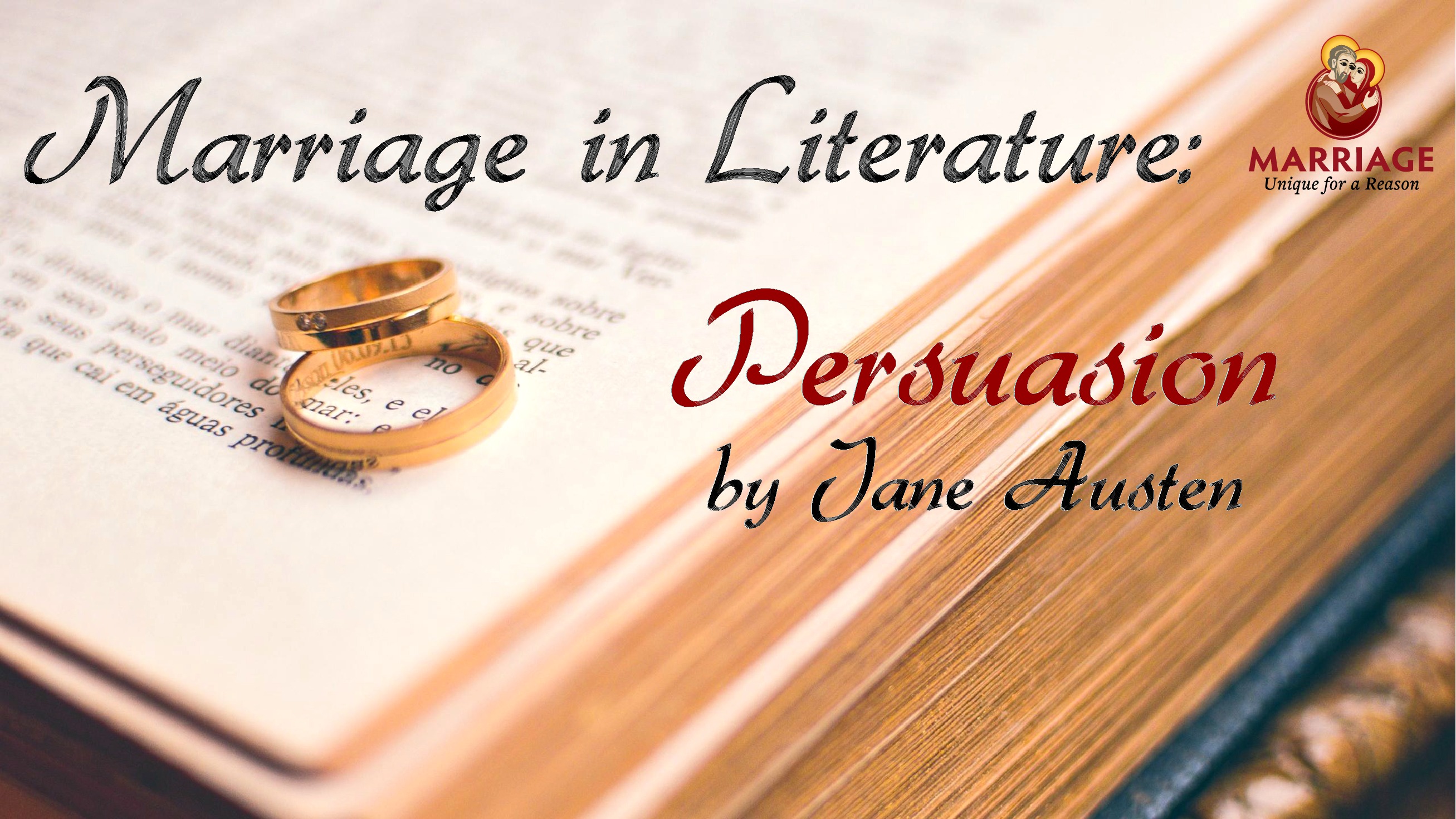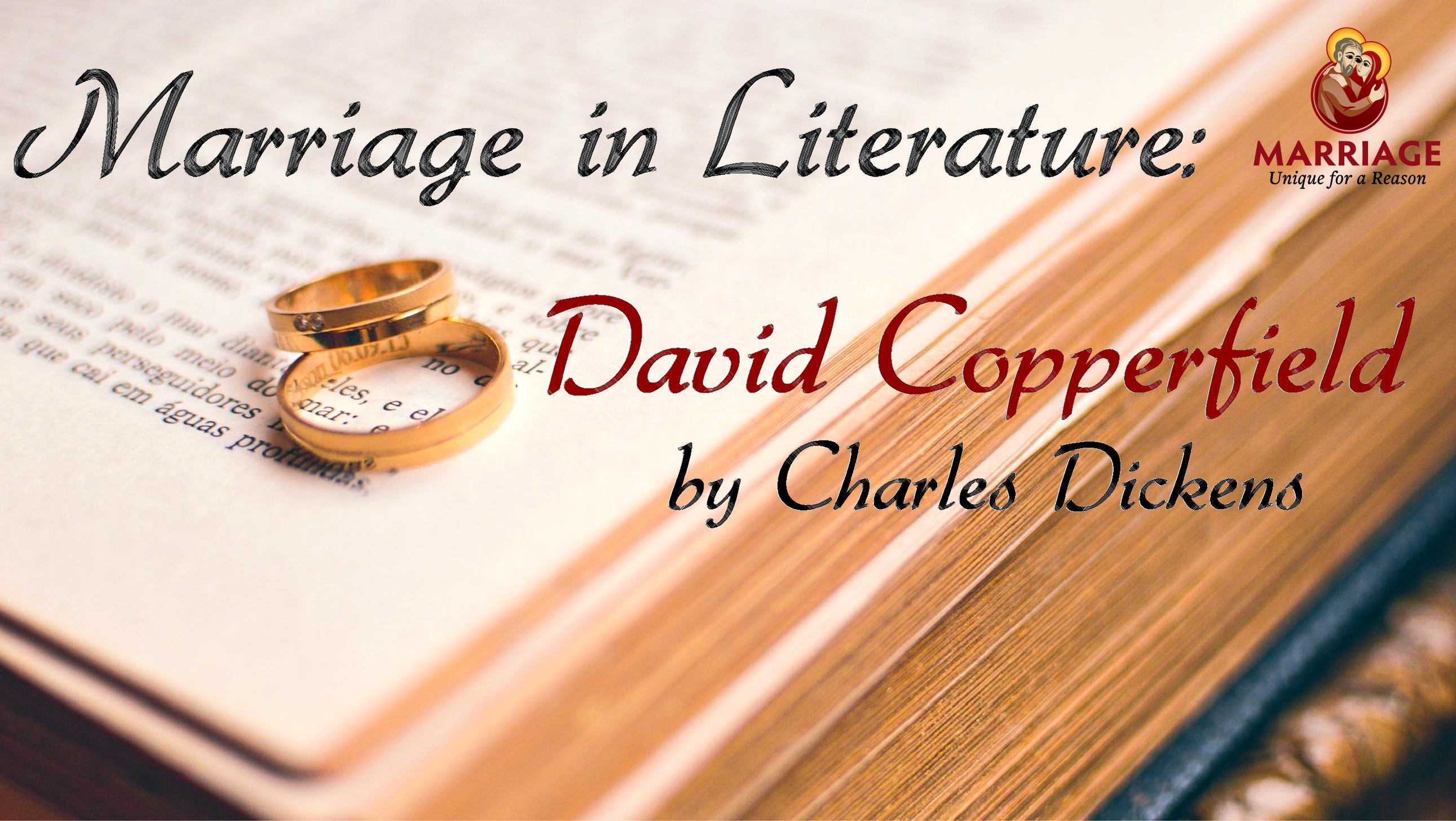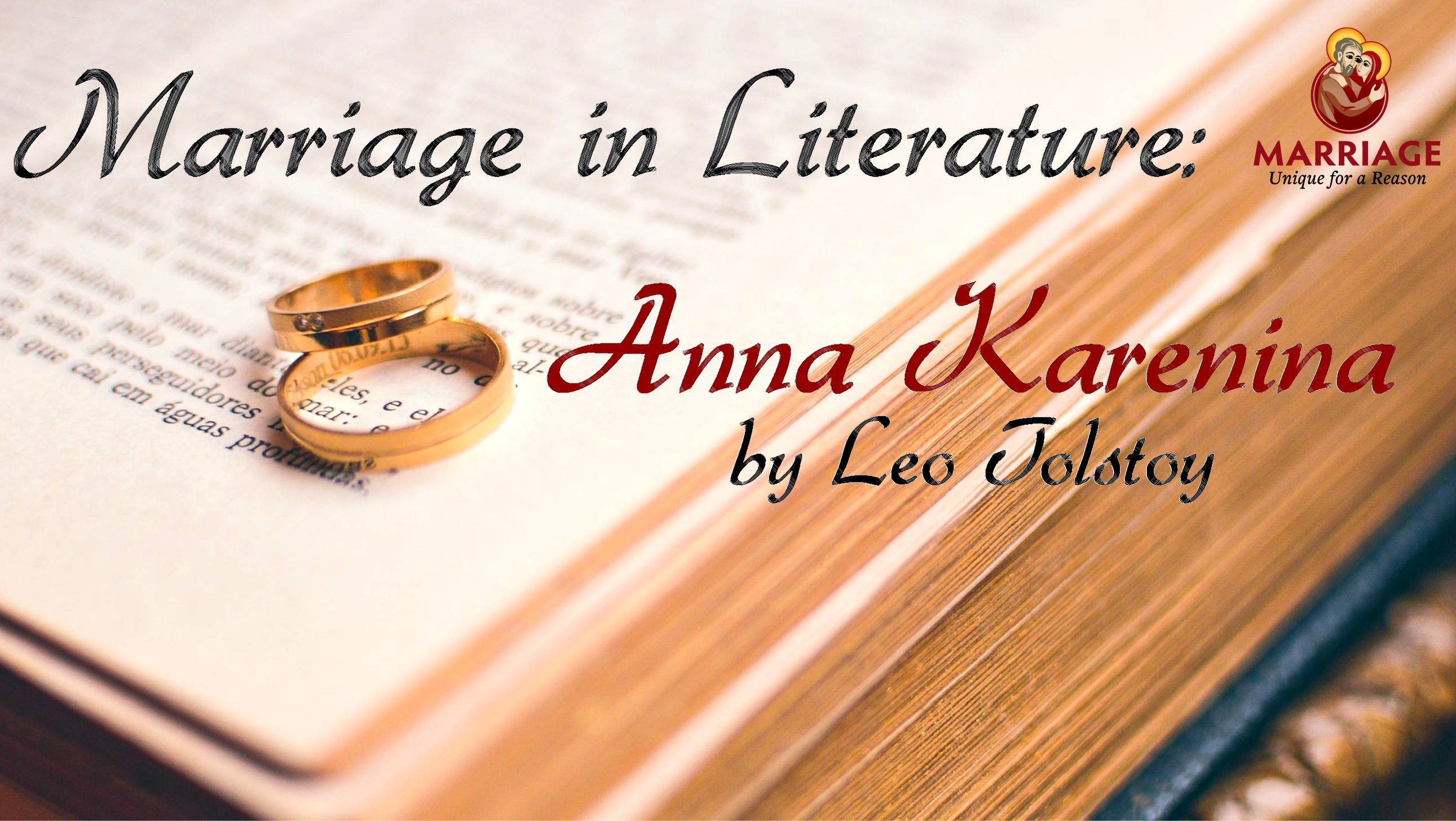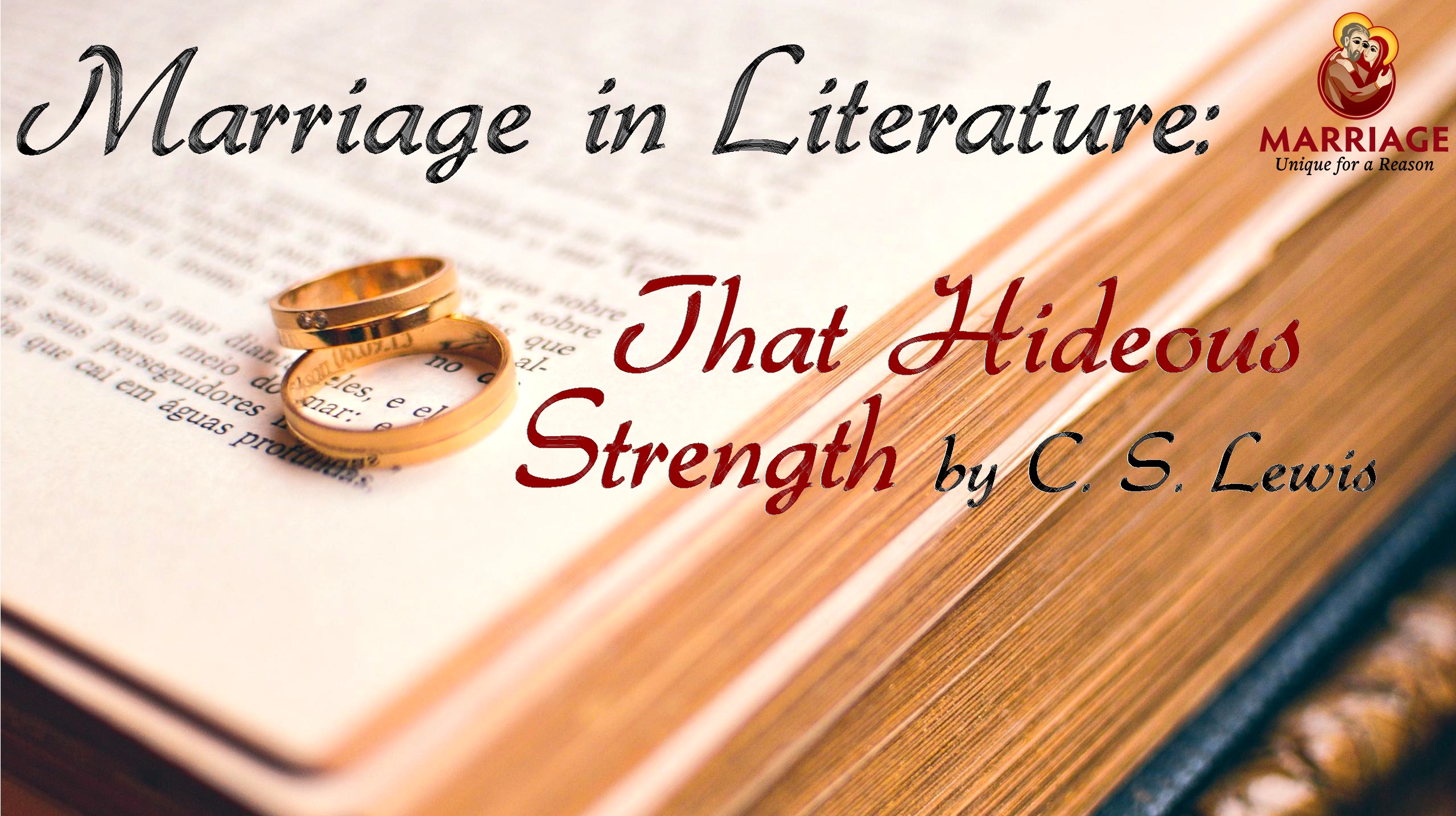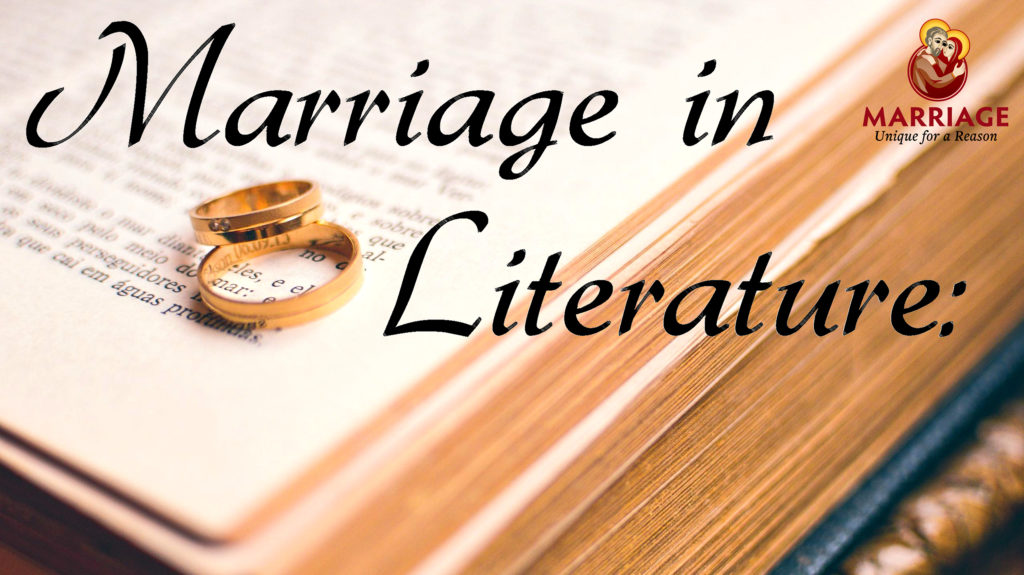“Parker’s Back”: Marriage in Literature Series
“Parker’s Back” by Flannery O’Connor (published 1965 in Everything that Rises Must Converge)
This short story by Flannery O’Connor revolves around the character of Parker who is constantly in search of something, and often fills this search by getting a new tattoo. He has so many tattoos, at a certain point, that the only “blank space” left is his back. It is there that he gets a tattoo of Christ’s eyes, copied from an icon he finds. But all this wandering and searching for Parker eventually comes back to his marriage. Let’s look at some of the elements of “Parker’s Back” that have to do with marriage:
- There is always some mystery in a man and woman’s choice of each other.
“Parker’s Back” opens with Parker looking at his pregnant wife, Sarah Ruth, who is sitting on the porch snapping beans. He is thinking about how plain she is, “puzzled and ashamed at himself” for staying with her. He is also confused by her marrying him: “Sometimes he supposed that she had married him because she meant to save him. At other times he had a suspicion that she actually liked everything she said she didn’t.” When they first meet, Sarah Ruth hits Parker in the face with a broom for swearing. Later, when he makes a move on her, she “thrust him away with such force that the door of the truck came off and he found himself flat on his back on the ground. He made up his mind then and there to have nothing further to do with her.” The next line has them married. It can be easy to wonder why you chose your husband or wife, especially when things are hard. Sometimes it seems like they would be more compatible with someone else, or you may meet someone you are more compatible with. These are opportunities to remember the beginning of your story with your spouse; what drew you to them in the first place, and how that love has grown over time.
- It is Christ who must be obeyed in marriage.
Parker goes to the tattoo parlor and asks for the book with “all the pictures of God in it” and finds a Byzantine Christ he chooses for his back because of the eyes. “[Parker] felt as though, under their gaze, he was as transparent as the wing of a fly.” Later, he realizes, “The eyes that were now forever on his back were eyes to be obeyed. He was as certain of it as he had ever been of anything.” Parker thought that when he returned home, Sarah Ruth would appreciate the face of Jesus on his back and see it as a way for Parker to be close to her; but Sarah Ruth does not really know Jesus: “It ain’t anybody I know,” she says when she sees the tattoo. Then she beats Parker across the back with the broom, “until she had nearly knocked him senseless and large welts had formed on the face of the tattooed Christ.” Christ is crucified again in Parker. We see Parker weeping under a tree in the last scene, at a total loss to understand what he could do to make his wife happy.
- Husbands, love your wives…
This doesn’t sounds like a hopeful story, does it? Yet somehow it is, because you have to think about Parker’s back, now carrying the icon of Christ, as he is being called to love a woman who hurts him. “Husbands, love your wives even as Christ loved the Church and handed himself over for her” (Eph 5: 25).
Archive
Persuasion: Marriage in Literature Series
Jane Austen’s Persuasion (published 1817)
Austen’s most popular novel is Pride and Prejudice, but the character of Anne Eliot, in Persuasion, deserves some attention. Of all Austen’s heroines, Anne is the one who waits the longest to receive her vocation to marriage. In these days of delayed marriage and dropping marriage rates in the United States and Europe, we should spend a little time with Anne Eliot.
Here is the basic story arc for those of you who are not Austen fanatics: Anne is the unloved, plainer daughter of an aging and irresponsible gentleman. As a young woman, she fell in love with a Naval man (Frederick Wentworth) whose prospects were uncertain and of whom her family did not approve. Anne was guided by a woman who acted as a mother to her (hence the title of the book), and broke the engagement. Wentworth left with wounded feelings and went on to make a fortune in the war as a Captain. He returns into Anne’s life bitter and resentful, and thus the story begins.
This post is for the single ladies:
- Patience is a suffering that both comes from and produces virtue.
Anne was quite young when she refused Captain Wentworth. She was persuaded by others at the time, but looking back she thinks that, “she should yet have been a happier woman in maintaining the engagement, than she had been in the sacrifice of it” (Ch. 4). During the intervening seven years, between Wentworth’s leaving and coming back, Anne does not wallow in regret or live in selfish preoccupation with what she lost. But she also does not compromise out of fear of being alone; Anne receives at least two proposals from other men but does not accept them. She is a virtuous woman; she suffers but does not despair. She endures the pain of recognizing that the man she refused would have been the best partner for her, and in doing so she becomes even more worthy of Wentworth’s love. Anne says: “All the privilege I claim for my own sex (it is not a very enviable one; you need not covet it), is that of loving longest, when existence or when hope is gone” (Ch. 23).
- There is a difference between the compromising that is necessary in marriage and the compromising of important values for the sake of getting married.
Compromise is important in any relationship. Anne’s future with Captain Wentworth will be full of things that they will compromise about; their temperaments are different and he is much worldlier than she is. But these compromises in marriage are fruitful and necessary. They do not mean that either of them “compromised” by marrying the other. Learning that Anne rejected Charles Musgrove is a moment that might disturb the reader, because Charles is a good man. Could Anne have been happy with Charles? Perhaps. She certainly would have been a better wife to him than her sister Mary is. But when you think about all of Anne’s interests and qualities, her quiet passion for poetry and music, her utter calm in a crisis and interest in travel, you can see that she would have been stagnant in a life with Charles. Then, when Mr. Elliot proposes to Anne, and Lady Russell urges Anne to accept him, we see an even more important refusal on the grounds of character. Even though Anne is practically an “old maid” by that time, Anne will not enter marriage without love.
- Look for a man who is authentic and trustworthy.
“Mr. Elliot was rational, discreet, polished, but he was not open. There was never any burst of feeling, any warmth of indignation or delight, at the evil or good of others. This, to Anne, was a decided imperfection. Her early impressions were incurable. She prized the frank, the open-hearted, the eager character beyond all others. Warmth and enthusiasm did captivate her still. She felt that she could so much more depend upon the sincerity of those who sometimes looked or said a careless or a hasty thing, than of those whose presence of mind never varied, whose tongue never slipped” (Ch. 17). Anne does not trust Mr. Elliot because he never shows what he is really thinking or feeling. He is always self-possessed and calculating in his words and actions. This is a good reminder for women to really pay attention to what a man reveals in his less guarded moments; and if there are none, pay attention to that too!
Archive
David Copperfield: Marriage in Literature Series
David Copperfield by Charles Dickens (published 1850)
The opening of David Copperfield is one of my favorite openings in literature. The chapter title is “I Am Born,” and the first line is: “Whether I shall turn out to be the hero of my own story, or whether that station will be held by anybody else, these pages must show” (p. 13). The pages do indeed show that David Copperfield makes a lot of mistakes, but finds his true home in his marriage to Agnes.
David Copperfield is a narrative of a boy’s growing into a man. After he is sent off to school, the reader meets many characters who will influence Copperfield’s trajectory, including one of the best villains in all of Dickens: Uriah Heep. (Heep endeavors to poison a marriage, similar to the character of Iago in Shakespeare’s Othello.) Through the story, we follow David’s blunders in relationships, particularly in his romantic choices.
The action of this novel can point out a number of truths about love, marriage and family.
- Men are radically free to choose their partner in life, and they ought to do so carefully.
Women only have the power of refusal, as Jane Austen puts it (see Northanger Abbey). And sometimes, other people can see more clearly than a man who thinks himself “in love.” David Copperfield falls in love with a silly, kind-hearted woman named Dora. He marries her, despite that it is obvious to his aunt (and the reader) that Dora is no equal match for him. Betsy Trotwood, David’s aunt and caretaker, upon hearing of his engagement, exclaims, “blind, blind, blind!” and she is right. But David has to learn the hard way that beauty and goodwill in a woman are not enough to make him happy in marriage. When Dora becomes ill—an illness that leads to death— David’s wife sadly acknowledges that their marriage would not have worked for very long: “As years went on, my dear boy would have wearied of his child-wife. She would have been less and less a companion for him. He would have been more and more sensible of what was wanting in his home” (p. 762). When David married Dora, he did something unfair not only to himself but also to her. She knew that she could never be an equal partner for him, and she could never be wholly content knowing that.
In contrast, what David finds in Agnes is a steady, faithful love that began in friendship and grew through selflessness. It is of this woman that David can say, “Clasped in my embrace, I held the source of every worthy aspiration I had ever had, the centre of myself, the circle of my life, my own, my wife, my love of whom was founded on a rock!” (p. 858). The foundation of his love for Agnes is much firmer than the infatuation which led him to marry Dora.
- One who loves is sometimes called to sacrifice his or her own desires for the beloved.
Dora, silly child bride that she was, genuinely loved David. At the end of her life, Dora asked David to send for Agnes, knowing that Agnes was the truest friend that she could have, and asked Agnes to take her place one day as David’s wife. Agnes takes care of Dora with love and true affection, showing that her love for David overflows even to the person he chose over her. David, likewise, once he is able to recognize his love for Agnes, shows it by saying that he would rejoice in her happiness if she loved another man. These are signs that their love has been purified to some extent of selfishness and self-seeking.
- Love sometimes means warning the other about something, while still respecting their freedom.
Agnes sees trouble in David’s association with his friend James Steerforth; she calls Steerforth David’s “Bad Angel” (p. 372). Agnes believes that Steerforth is a “dangerous friend” for David, but notes that she does not expect David to change his mind about him just because she says so (p. 372). She simply asks him to think about it. Often, married couples can fall into one extreme or the other when it comes to the issue of helping the other avoid temptation. One extreme is to care little for the other’s temptations and what you could do to help them combat them; the other is to bring things that the other struggles with up so often that it reveals that you want to control them and do not respect that they have to choose for themselves.
What does a balanced approach to these issues look like? Are there times when it is appropriate to bring sin or temptation up and times when it is not? How does the Holy Spirit guide couples when it comes to individual temptation?
Archive
Anna Karenina: Marriage in Literature Series
Anna Karenina by Leo Tolstoy (published 1877)
Tolstoy’s Anna Karenina, while clearly diagnosing the problems of lust and adultery through the main protagonist, also offers a more sanguine view of love, marriage and family through the relationship of Levin and Kitty.
Five elements for consideration:
- Emotional maturity is important in love.
Levin persists in caring for Kitty even after she rejects him—she, like Anna, was infatuated with the dashing Vronsky at the time that Levin proposed. Levin does not nurse his feelings of rejection, reproach her, or demand some sort of apology for her not choosing him first. Instead, he is grateful and content to receive her love when she is ready. In their first meeting after a number of years, “[Kitty] and Levin had a conversation of their own, yet not a conversation, but a sort of mysterious communication, which brought them every moment nearer, and stirred in both a sense of glad terror before the unknown into which they were entering” (p. 461). Levin experiences the emotional high of being “in love” the day he goes to Kitty’s house to receive her parents’ consent to their marriage: “All that night and morning Levin lived perfectly unconsciously, and felt perfectly lifted out of the conditions of material life” (p. 475). He wants to marry her the very next day, if possible, but her parents add a dose of prudence (and a trousseau). None of this joy would have been possible if Levin had held on to pride, jealousy, or resentment.
- The love between man and woman is a common experience that draws a community together.
After he becomes engaged to Kitty, Levin is surprised because, “He had thought his engagement would have nothing about it like others, that the ordinary conditions of engaged couples would spoil his special happiness; but it ended in his doing exactly as other people did, and his happiness being only increased thereby and becoming more and more special more and more unlike anything that had ever happened” (p. 481). Kitty also feels that the time was one of “utmost bliss and the utmost misery” (p. 533). Instead of his joy being dampened by the fact that other couples had felt the same way, Levin realizes that this fact is a joyful one. He is entering into the state of Matrimony where many have been before him, and many will follow. His vow joins him in a way to all those who have made the same vow. This is part of the beauty of saying the traditional vows at a wedding ceremony; being conscious of all those who have said, and will say, those same words.
- It is important for a man and a woman who are considering marriage not to conceal things from one another.
Levin decides to confess to Kitty that he is not a virgin: “He knew that between him and her there could not be, and should not be, secrets, so he had decided that so it must be” but he is surprised by how affected she is by it (p. 482). She forgives him, “but it’s terrible!” she exclaims (p. 482). Levin’s past actions, especially his sexual experiences, affect his current relationship. This is always true. In marriage, this transparency must continue. Today, one may think of pornography and the way that spouses may try to conceal these struggles from each other. This lack of transparency, while it may seem to be protective, erodes trust between spouses. (This is not to say that one’s spouse should be one’s accountability partner, simply that the struggle should not be a hidden one)
- Weddings are blessed times for all married couples to recall their own promises.
Levin is keenly aware of the mystery of the Sacrament of Matrimony during his own wedding: “Levin felt more and more that all his ideas of marriage, all his dreams of how he would order his life, were mere childishness, and that it was something he had not understood hitherto, and now understood less than ever, though it was being performed upon him. The lump in his throat rose higher and higher, tears that would not be checked came into his eyes” (p. 524). But it was also an occasion for others in the congregation: “[Dolly] was deeply moved… She was rejoicing over Kitty and Levin; going back in thought to her own wedding, she glanced at the radiant figure of [her husband], forgot all the present, and remembered only her innocent love… with love and hope and dread in their hearts” (p. 536). Attending weddings together, married couples may contemplate their own growth in their vocation.
- Marriage, even a happy marriage, is not easy.
Levin is surprised and disappointed to learn that complete marital bliss does not follow the wedding. “[He] could never have conceived that between him and his wife any relations could arise other than tender, respectful and loving, and all at once in the very early days they quarreled, so that she said he did not care for her, that he cared for no one but himself, burst into tears, and wrung her arms” (p. 565). Levin found that while he wanted to blame Kitty for these fights, he longed to “make up” even more. Tolstoy writes that the first three months of marriage were very difficult for these two. Throughout the novel, Levin and Kitty experience misunderstanding, jealousy, anger and pain in their relationship, yet it must truly be said in the end that theirs is a happy marriage. This can be a good reminder to married couples when they experience a dry or difficult period in their marriage.
Archive
That Hideous Strength: Marriage in Literature Series
That Hideous Strength by C. S. Lewis (published in 1945)
The last of his “Space Trilogy,” C. S. Lewis’s That Hideous Strength explores Christian marriage as a force for good in the world. The book opens this way: “‘Matrimony was ordained, thirdly,’ said Jane Stubbock to herself, ‘for the mutual society, help, and comfort that the one ought to have of the other.’ She had not been to church since her schooldays until she went there six months ago to be married, and the words of the service had stuck in her mind”(p. 11). The novel begins with Jane’s contemplation of how marriage has not turned out the way she thought it would, and ends with Jane and her husband, Mark, recognizing the deep meaning of their marriage.
Here are three things that we can contemplate about marriage through this novel:
- Open communication between spouses is both important and difficult.
Despite being a fantasy novel, there is great realism in Lewis’s depiction of the spats and subtexts of married life. The whole of Chapter two, part three, is devoted to a conversation between Jane and Mark about whether Jane minds Mark’s staying out of town for a few days. It references tones of voice and Jane’s internal dialogue. Lewis notes that at times neither of the spouses really knows what he/she is doing or why. After their morning spat, in which they are clearly not understanding one another, Lewis writes, “The upshot of it was that Mark gave himself a very bad cut while shaving… while Jane decided, through a mixture of motives, to cook Mark an unusually elaborate breakfast—of which she would rather die than eat any herself—and did so with the swift efficiency of an angry woman, only to upset it all over the new stove at the last moment. They were still at the table and both pretending to read newspapers when Lord Feverstone arrived” (p.45-46). A seemingly simple question (Mark’s, “Do you feel quite alright this morning?” quickly led the characters through a wide range of emotions and confusion because of other unresolved issues in their marriage.
- Married couples are fruitful in many ways besides natural children.
In the fight between good and evil which is at the heart of That Hideous Strength, married couples play a key role. Dr. and Mrs. Dimble, for example, are important characters fighting for good. This couple is a great example of the spiritual fruitfulness of Christian marriage. Mrs. Dimble says, almost in passing, that she does not mind losing their home too much because it had “all those big upper rooms which we thought we should want because we thought we were going to have lots of children, and then we never had” (p. 75). But as she and her husband work for the cause of truth in the “Director’s company,” Mrs. Dimble is referred to as “Mother Dimble” and consistently takes care of the other members of the group (p.162). The Dennistons and the Maggses, other married couples, are also important to the company, which is a small band of committed people who are attempting to live their lives with love. This simple group is depicted as opposing huge machinations of evil on the other side of a conflict for the world’s future.
- Marriage is what God says it is; and this truth sets us free.
When Mark has fallen in with the wrong crowd (i.e. evil), the Director (good) tells Jane, “It would be hard for the same person to be the wife of an official [in the evil group] and also a member of my company” because they could not all trust each other (p.142). The Director wants her to convince Mark to leave the evil group by using her love as his wife. She rebels at this idea and says that the Director has a different idea about marriage than hers. “It is not a question of how you or I look on marriage but on how my Masters look at it,” the Director says (p. 144). When she finally comes around to the Director’s reasoning, Jane feels both free and beautiful, and makes the decision to “give Mark much more than she had ever given him before, [with a] feeling that in doing so she would really be giving it to the Director” (p.148). Mark, for his part, longs to be with Jane and believes that doing so “would clean away all the filth that seemed to hang about him” from his association with evil (p.186). They both realize that the path to loving God is through the other.
In the end, Mark and Jane come to recognize their own flaws and the ways they have hurt one another. They approach one another in humility and love. May all married couples do the same, and by so doing, contribute in their own way to the salvation of all.
Archive
The Scarlet Letter: Marriage in Literature
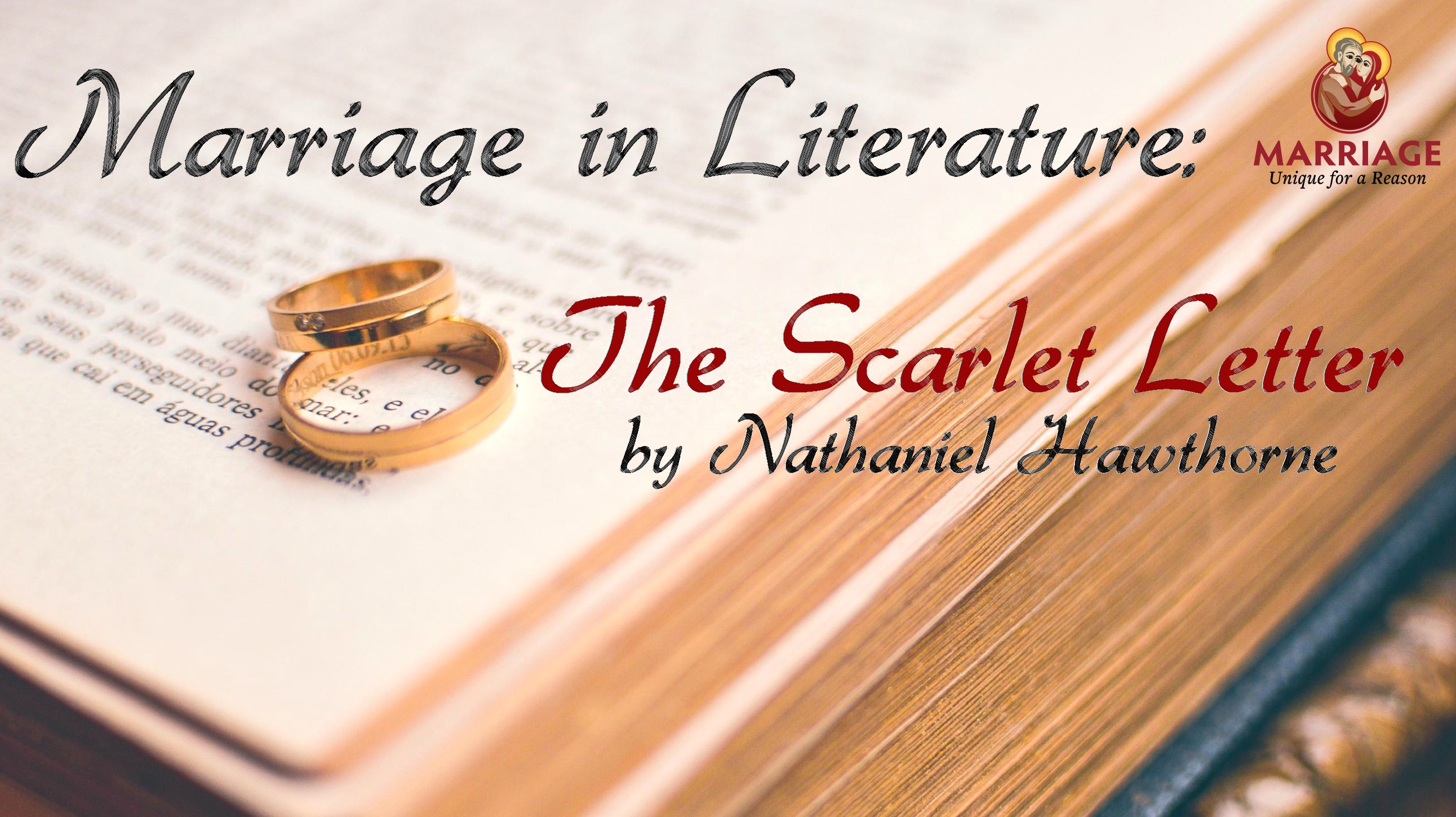 The Scarlet Letter by (published in 1850)
The Scarlet Letter by (published in 1850)
In Nathaniel Hawthorne’s most well-known work, The Scarlet Letter, we get a glimpse of a Puritan community and particularly their sexual ethic and harsh judgment of those who do not comply.
Hester Prynne is not an innocent woman; she has committed adultery and given birth to a child outside of wedlock. Everyone in the community knows that the baby is “illegitimate” since Hester’s husband is visibly absent, having not arrived in America yet. Hester neither proclaims innocence nor gives excuses for her behavior, even though, when her husband is revealed, it is abundantly clear that there is no love between them. Hester refuses to name the child’s father, sparing that man the public shaming that she faces every day.
This novel can lead us to consider a number of things about marriage. Here are a few:
- Marriage is, among other things, a surrendering of your capacity to procreate to your spouse.
In marriage, a husband and wife give to each other not only their whole present selves, but also their future prospects of procreation. The mutual gift of fertility is not a part of the marital covenant to be taken lightly. It means not only openness to however many children God gives you (while being open to life and also exercising responsible parenthood) but also the converse: acceptance if God does not give you children. We know from the proliferation of IVF and other methods of procreating that this latter issue is also a struggle for many people.
Hester’s child, Pearl, is the concrete proof of her infidelity and a sign to the community of a broken vow.
- Adultery affects not only the married couple, but the whole community.
Public shaming is not a good thing; no one wants to go back to the time depicted in The Scarlet Letter! But neither do we want to accept the idea that adultery is fine under certain circumstances— such as if the spouses agree to have an “open” relationship or if the new relationship seems to be making the person “happier”. Adultery strikes at the heart of marriage and the family, even when it is secret and “no one knows” about it. Then, when it does become known, the spouse and children are naturally the most affected, but so is the entire community, starting with the extended family and friends of the couple, rippling through the Church community, and then to the broader community. Indeed, everyone is affected in some way by an example of infidelity. It makes the virtue of fidelity that much harder to practice for anyone who is struggling with it. It may even suggest to a struggling person that fidelity is impossible or that it’s “not worth it.” A new vulnerability emerges in every one of the marriages in the community. People who identified themselves with the other couple start wondering how strong their own marriages are, questioning their spouses, feeling insecure. Many people feel betrayed by the man or woman who was unfaithful, even when they are not the immediate family. Adultery is not a private sin.
- Children have the right to know their mother and their father.
Hester’s daughter, Pearl, is described as an “elf-child” who seems to “hover about the enigma of the scarlet letter”(p.170). Pearl seems to know, in a mysterious way, that Reverend Dimmesdale is her father, saying that Hester’s scarlet letter is there, “for the same reason that the minister keeps his hand over his heart” (p. 171). She is conscious of a bond between her natural mother and father even though Hester never acknowledges it. Pope Francis said, “We must reaffirm the right of children to grow up in a family with a father and a mother.” Perhaps Pearl would not be so eccentric if she could know and be embraced by her father. Or maybe she would just be a happier eccentric!
4. Sin does not have the last word.
One of the most important things we can reflect on after reading The Scarlet Letter is that Hester Prynne is sanctified by her repentance. Hawthorne writes that “the scarlet letter had the effect of the cross on a nun’s bosom” (p.157). Sin does not have the last word. All is not lost!
Archive
Marriage in Literature Series
A series on Marriage in Literature, written by staff at the USCCB, is meant to bring out just a few of the lessons about marriage that are supplied by works of literature. It will not go into great depth on any one given work, but will simply draw out three or four aspects about marriage and family life that the work suggests. Previous knowledge of the plots of each novel will be presumed!
Here are the books that will be discussed:
- The Scarlet Letter by Nathaniel Hawthorne (Read series here)

- That Hideous Strength by C.S. Lewis (Read series here)
- Anna Karenina by Leo Tolstoy
(Read series here) - David Copperfield by Charles Dickens (Read series here)
- Strong Poison, Gaudy Night, and Busman’s Honeymoon by Dorothy Sayers (Read series here)
- Persuasion by Jane Austen (Read series here)
- “Parker’s Back” (short story) by Flannery O’Connor (Reflection to be posted)
